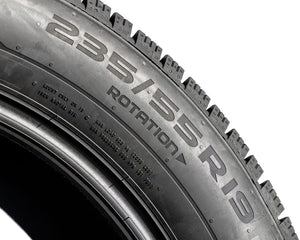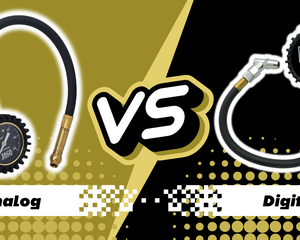
Managing tire pressure is an essential part of car maintenance often overlooked by many. The right pressure in your tires doesn't just optimize your vehicle's performance and fuel economy, but also ensures your safety on the road. But how does one keep tabs on their tire pressure? That's where tire pressure gauges come in, providing accurate readings and peace of mind. In this blog post, we'll explain how tire pressure gauges work and guide you through the different types available in the market.
The Science Behind Tire Pressure Gauges
Basic Principle of Tire Pressure Measurement
The underlying principle of tire pressure gauges is the same as any pressure measuring device. They measure the force exerted by air on a unit area, typically given in pounds per square inch (PSI). When you connect a tire pressure gauge to your tire's valve stem, it forms a sealed system. The air pressure within the tire pushes against a sensing element in the gauge, causing it to move or change shape. This movement or deformation is then converted into a readable pressure value.
How a Tire Pressure Gauge Reads the Air Pressure Inside the Tire
The way a tire pressure gauge reads the pressure varies depending on its design. In mechanical gauges like bourdon tube or pencil gauges, the air pressure causes a physical element to move, and this movement is translated into a pressure reading on a scale. Digital gauges, on the other hand, use electronic pressure sensors that convert pressure into an electrical signal, which is then processed and displayed as a numerical value on an LCD screen. We will explore these different types of gauges in more depth later in this post.
Overview of Different Types of Tire Pressure Gauges
So, why are there different types of tire pressure gauges? Just like any tool, the variation caters to diverse needs, preferences, and applications. Each type of tire pressure gauge comes with its unique set of features, benefits, and potential drawbacks, which we will cover in the following sections. Here, we'll take a deep dive into four of the most common types: Bourdon tube gauges, diaphragm gauges, digital gauges, and pencil or stick gauges. Whether you're a car enthusiast or a casual driver, understanding these types will help you make an informed decision when selecting a tire pressure gauge that best suits your needs.

Bourdon Tube Pressure Gauges
Named after its French inventor, Eugène Bourdon, the Bourdon Tube Pressure Gauge is a mechanical device dating back to the mid-1800s. This type of gauge has stood the test of time due to its reliable and straightforward mechanism.
How Bourdon Tube Gauges Work
The essential part of a Bourdon tube gauge is a curved, hollow, and flexible metal tube known as the Bourdon tube. The open end of the tube is connected to the tire valve, and the other end is sealed. When air pressure from the tire enters the tube, it straightens, causing a mechanical linkage to move the needle on the gauge dial, indicating the tire's pressure.
Pros and Cons of Using Bourdon Tube Gauges
Bourdon tube gauges are known for their durability, precision, and ability to withstand harsh environments. However, they may not be as user-friendly to read as their digital counterparts, particularly in low light conditions. Furthermore, they are more susceptible to inaccuracies if dropped or jostled due to their mechanical nature.

Diaphragm Pressure Gauges
Another type of mechanical gauge is the Diaphragm Pressure Gauge. As the name suggests, these gauges rely on a diaphragm, a flexible membrane that responds to pressure changes.
How Diaphragm Gauges Work
In a diaphragm pressure gauge, air pressure from the tire pushes against the diaphragm, causing it to deform. This deformation is transferred through a mechanical linkage to move the needle on the gauge dial, reflecting the tire's pressure. Since the diaphragm can only deflect a certain amount, these types of gauges are ideal for lower pressure readings.
Advantages and Disadvantages of Diaphragm Pressure Gauges
Diaphragm pressure gauges are compact and resistant to vibration, making them a durable choice. They're excellent for providing precise readings, especially in lower pressure ranges. However, they may not be as accurate in higher pressure ranges. Furthermore, similar to Bourdon tube gauges, they may be harder to read in dimly lit conditions compared to digital gauges.

Digital Pressure Gauges
Digital pressure gauges are a modern take on the classic tire pressure measuring device. They offer a user-friendly interface and high accuracy, which has led to their increasing popularity among users.
How Digital Gauges Function
Unlike mechanical gauges, digital gauges use electronic sensors to measure pressure. When you attach the gauge to the tire valve, air pressure from the tire acts on the sensor, which converts the pressure into an electrical signal. This signal is then processed and displayed on a digital screen as a pressure reading, often with the option to switch between various units of measurement.
Benefits and Drawbacks of Digital Pressure Gauges
One of the primary benefits of digital gauges is their ease of use. With a clear digital display, they eliminate the need to interpret dial readings, which can be particularly beneficial in low light conditions. Digital gauges are also highly accurate and often offer additional features, such as the ability to deflate tires directly from the gauge. However, they are typically more expensive than their mechanical counterparts and require batteries to operate, which can be a downside for some users.

Pencil or Stick Pressure Gauges
Pencil or stick pressure gauges are a simple, compact, and affordable option for measuring tire pressure. As the name suggests, these gauges resemble a pencil in their design.
How Pencil/Stick Gauges Work
When a pencil gauge is inserted into a tire valve, the air pressure from the tire pushes against a calibrated spring inside the gauge. This causes a rod (or "pencil") to extend from the gauge's body. The exposed length of the rod correlates with the pressure inside the tire, with measurements typically marked on the rod itself.
Pros and Cons of Pencil/Stick Pressure Gauges
Pencil gauges are a cost-effective solution, they're compact, lightweight, and require no batteries, making them an excellent choice for an emergency tire pressure check tool. However, they are generally less accurate than Bourdon tube, diaphragm, or digital gauges and can be more difficult to read due to their small size and manual reading method.

Comparing Tire Pressure Gauges
Choosing the right tire pressure gauge depends on several factors. These include accuracy, ease of use, price, durability, and any additional features you might find useful, such as a backlit display or built-in flashlight for night use.
| Type | Accuracy | Ease of Use | Price |
|---|---|---|---|
| Bourdon Tube Gauges | High | Moderate | Medium |
| Diaphragm Gauges | High | Moderate | Medium |
| Digital Gauges | Very High | High | High |
| Pencil/Stick Gauges | Moderate | High | Low |
How to Use a Tire Pressure Gauge Correctly
Regardless of the type of gauge you use, it's crucial to use it correctly to ensure accurate readings. Here's a general step-by-step guide on how to use a tire pressure gauge:
- Remove the valve cap from your tire.
- Attach the pressure gauge to the valve stem. If using a digital or mechanical gauge, ensure a tight seal is formed.
- Read the tire pressure from the gauge. For digital gauges, the reading will appear on the display. For mechanical gauges, the dial or rod will indicate the pressure.
- Replace the valve cap securely.
For the most accurate reading, check tire pressure when your tires are cold, as heat can cause tire pressure to increase. It's recommended to check tire pressure at least once a month and before long trips.
Final Thoughts
In this article, we have unraveled the science behind tire pressure gauges, explaining how they work and the mechanisms behind each type. We looked at Bourdon tube gauges, renowned for their precision and robustness. Diaphragm gauges, though less common, also offer high accuracy and durability.
Digital gauges, on the other hand, are extremely accurate, easy to read, and often come with additional features such as backlit displays. Lastly, pencil or stick gauges, the simplest and most affordable option, are easy to use but less accurate than the other types.
Understanding how different tire pressure gauges work and their pros and cons can help you make an informed decision about the best gauge for your needs. Regularly checking your tires' pressure with a reliable gauge is crucial for vehicle safety, performance, and fuel efficiency.
We encourage you to check out our collection of calibrated accurate digital and analog tire pressure gauges. Designed for convenience and accuracy, they'll make the task of maintaining optimal tire pressure effortless and precise. Remember, a well-inflated tire is the first step towards a safe and smooth journey.





